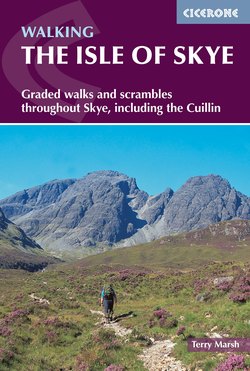Читать книгу The Isle of Skye - Terry Marsh - Страница 12
На сайте Литреса книга снята с продажи.
ОглавлениеWALK 1.1
Gleann Meadhonach, Loch a’Ghlinne and Dalavil
| Start/Finish | Roadside parking (limited) on minor road to Achnacloich (NG622068) |
| Distance | 12km (7½ miles) |
| Total ascent | 255m (835ft) – mostly on the return journey |
| Map | OS Explorer 412 |
Sleat is not renowned for an over-abundance of walking opportunity. Though possessing a fascinating coastline of rocky inlets and tiny beaches, the hinterland is a troubled landscape of heathery knolls and boggy, lochanridden moorland, punctuated sparsely by man’s efforts to win a living from it. That he often fails is evidenced by the ruined crofts and agricultural buildings that dot the scene, though some, as along this walk through Gleann Meadhonach to secluded Dalavil, are as a result of clearances carried out on the Island during the 19th century.
Leave the minor road that links Kilbeg and Achnacloich by turning onto a broad track, part of the Clan Donald Land Trust, that descends to a barrier and then continues uneventfully, save for a number of passageways through deer fences, into the undulating landscape of Gleann Meadhonach. This is a lovely, peaceful landscape, typical of remote Skye, and a great pleasure to walk.
When the broad track ends (at NG617058), another, less substantial and prone to minor bouts of bogginess, takes over and leads across the Abhainn a’Ghlinne Meadhonaich and its tributary burns a number of times. A quiet approach may well be rewarded with glimpses of otters and adders, while an eye on the surroundings hills may spot a cruising eagle or herd of deer.
Walking in Gleann Meadhonach (Walk 1.1)
Eventually you arrive at a ruined croft (NG603056), close by a deer fence, with Loch a’Ghlinne in view ahead. The loch is a favoured haunt of wintering whooper swans.
The route continues through the deer gate and along a waymarked path (boggy at times) into the woodland of Coille Dalavil. This area is protected from sheep and deer and is a Site of Special Scientific Interest by virtue of its colonies of dragonfly, damselfly and lichen.
The path continues through the lower part of the woodland, eventually emerging from the trees above the watercourse that the former inhabitants of Dalavil constructed to drain the surrounding land and the loch: the loch itself is barely 6m (20 feet) above sea level, and much of the glen is frequently waterlogged.
An on-going path leads to the remains of Dalavil township, and in due course the sea. If you keep to the higher ground above Dalavil, you will experience a beautiful moment as the inlet of Inver Dalavil springs into view. To the north-west the Elgol peninsula is set against the bulk of the Red Cuillin, with the Black Cuillin rising starkly above the low island of Soay, once used as a base by Gavin Maxwell for a shark fishery, and recounted in his book Harpoon at a Venture. Out to sea, the Cuillin of Rhum stand darkly on the horizon, with the island of Eigg to their left. When you have explored sufficiently, simply retrace your steps to the Achnacloich road.
Loch a’Ghlinne
DALAVIL
As Jim Crumley points out in The Heart of Skye, Dalavil, as you find it today, is the product of a motive that bred ‘maximum profit and the minimum inconvenience for an accursed breed of morally corrupt landlords’. Yet, unlike other cleared townships, such as Suisnish and Boreraig, Dalavil was cleared for an altogether different reason, at the time of the Education Acts of 1870–1872. Writer David Craig (On the Crofters’ Trail) records: ‘It was for the children to get their schooling. It was cheaper to clear the crofters than to build a school there. It was quite isolated – there was no road to it, just a path over the hill. It was a very good place for fishing, plenty of mackerel, and ling, and again there was shellfish too, and there was a lot of [sea]weed for their crops, for their potatoes and whatever they were turning’.
Here the families were mostly the MacKinnons, MacGillivrays and Robertsons. As their children grew they looked up at ‘the terraced black drop of Doire na h’Achlais where wild water sheds its veils and jets of spume and wondered, ‘When will it stop? Why does it come in jerks instead of smoothly?’’
